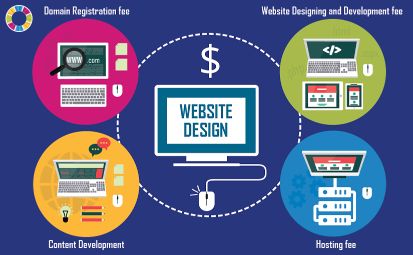Introduction
When it comes to the perplexing realm of website design costs, a multitude of factors conspire together in a burst of chaos, influencing the ultimate price tag. One crucial consideration lies within the intricacy and bewildering complexity of the design itself. Websites adorned with convoluted layouts and dazzling features demand an extraordinary amount of time and expertise to bring into existence, inevitably resulting in exorbitant costs.
Furthermore, one must take into account the sheer magnitude and vastness of the website in question. Websites that sprawl across countless pages and encompass numerous sections naturally command an amplified investment in both time and effort during their conception and development phase, thus inexorably inflating their overall monetary requirements.
Yet another variable capable of wreaking havoc on website design costs is none other than the client’s desire for customization. While pre-designed templates exist aplenty, certain enterprises yearn for a distinctive masterpiece that harmoniously mirrors their unique brand identity. As customization reaches dizzying heights, so too does the designer’s laborious undertaking grow exponentially.
Moreover, should additional functionalities such as e-commerce integration or multimedia elements be requested by clients who crave nothing short of greatness? Brace yourself? These desires will undoubtedly send shockwaves through any budgetary constraints initially established. Thus do these weighty considerations warrant scrupulous contemplation before entering discussions with designers; only then can harmony between cost and aspiration truly be achieved.
Different Types of Website Designs
When it comes to website design, the possibilities are perplexingly diverse. There is no one-size-fits-all approach that can adequately capture the burstiness of creativity and functionality that each website demands. The landscape of websites is a vibrant tapestry woven with distinct designs and layouts, tailored meticulously to cater to various purposes and target audiences.
One frequently encountered archetype in website design is the basic informational website. These virtual realms often serve as digital hubs for businesses or organizations seeking to disseminate information about their products, services, or mission statements. Their essence lies in simplicity – straightforward layouts adorned with intuitive navigation menus and uncluttered design elements.
Another fascinating specimen in the realm of web design is the e-commerce website. These digital marketplaces have been intricately crafted to facilitate seamless purchasing experiences for customers who seek convenience at their fingertips. Within these online domains, product catalogs materialize like virtual shelves while shopping carts patiently await their turn on this bustling stage. Secure payment gateways graciously shepherd transactions toward completion, ensuring customer satisfaction remains paramount at every step of the journey. E-commerce websites demand the utmost attention when it comes to user-friendly product filters, checkout processes that flow effortlessly like a cascading waterfall, and visually captivating displays meant to captivate and retain discerning customers.
Beyond these well-known archetypes lie countless other enigmatic designs waiting eagerly for discovery and exploration: portfolio websites showcasing creative showcases; blog websites fostering knowledge-sharing endeavors; and social networking platforms connecting individuals across vast cyber landscapes! Each genre necessitates specific elements interwoven harmoniously into its fabric – an alchemic blend of form and function carefully brewed with purposeful intent.
For businesses or individuals venturing into the boundless realm of online presence establishment, comprehending these myriad forms becomes not just advisable but crucial! Embark upon this journey armed with knowledge – embrace perplexity as your guide through this labyrinthine world where burstiness reigns supreme!

Components of Website Design
When delving into the realm of website design, one is confronted with a multitude of intricate components that collectively shape the site’s appearance and functionality. Amongst these, the layout emerges as an eminent factor, dictating the precise arrangement and organization of diverse elements on each page. A flawlessly crafted layout possesses the potential to elevate user experience by facilitating seamless navigation and expeditious discovery of desired information. Furthermore, let us not overlook the paramount significance bestowed upon color schemes in crafting a visually captivating website. The selection of colors must harmoniously meld together while embodying the very essence and identity of the brand.
Typography stands resolute as yet another indispensable facet within web design’s realm. The choice of font style and size exerts a profound influence upon both legibility and overall aesthetic appeal exhibited by said site. It remains imperative to opt for fonts that effortlessly grace various devices across myriad screen dimensions without compromising readability in any capacity. Additionally, the judicious incorporation of apt images and graphics holds tremendous potential for enriching a website’s visual allurement. By incorporating high-quality images germane to its content, one can effectively seize hold of users’ attention whilst accurately conveying intended messages in their entirety.
- The layout is an important component of website design, determining the arrangement and organization of elements on each page.
- A well-crafted layout enhances user experience by enabling easy navigation and quick access to the desired information.
- Color schemes play a crucial role in creating visually appealing websites that reflect the brand’s identity.
- The selection of colors should harmonize with each other while representing the essence of the brand.
- Typography is another essential aspect of web design, influencing both legibility and overall aesthetic appeal.
- Fonts should be chosen carefully to ensure readability across different devices and screen sizes.
- Incorporating relevant images and graphics can greatly enhance a website’s visual appeal.
- High-quality images that align with the content capture users’ attention and effectively convey messages.
Conclusion
To wrap it up, understanding the costs of website design is crucial for budgeting and planning. By exploring the various factors discussed, individuals and businesses can make informed decisions and invest wisely in creating effective and appealing online platforms.
